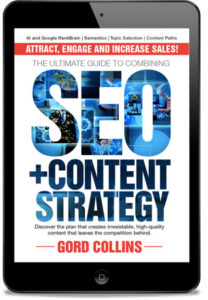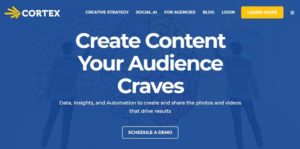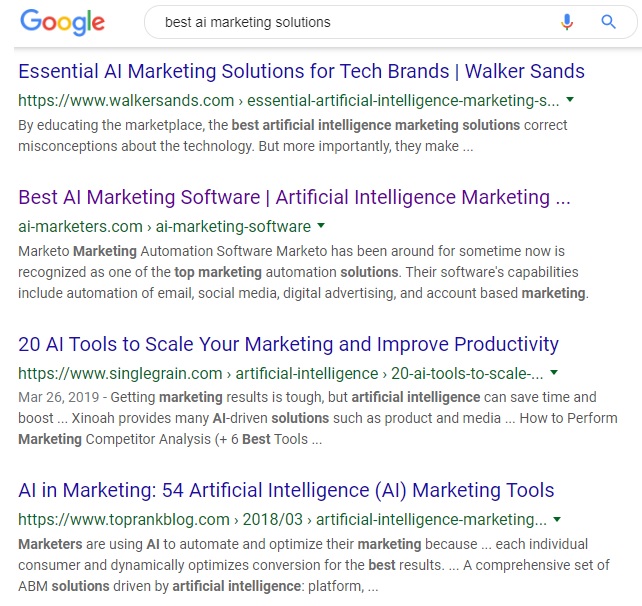What is Your Top Prospect’s Intent?
I wrote about keyword intent many years ago, but it seems Google and Bing couldn’t really determine searcher intent until 2019. Now they’re making it a big part of their indexing algorithm.
How do they detect intent? They can infer it from keywords used on search engines, content visitors view and engage with and compare to behaviors of previous “similar profiles” they’ve gathered from past visitors. When people become returning customers, a lot can be learned about them and what their interests are and intent might be.
Now in 2021, it’s a big thing and a key new addition to Google’s ranking algorithm (and Bing too) called BERT. This is a slightly complicated topic but I think you’ll understand the implications of the new Google component and why it’s being called the “biggest improvement in search in a long time.”

BERT is a complicated bit of search science that analyzes sentences for meaning as though it was a human (natural language). BERT discovers searcher intent. It will used along with other search components like Rankbrain.
Keywords aren’t just keywords anymore. And Google and Bing are looking much deeper than links and keywords. Their quest is to provide the best single answer for each unique visitor by diving into meanings. This quest would mean an end to traditional search engine optimization, and better sales conversion rates.
This is important because as Google ignores keywords, and pays attention to other words on pages, it means billions of current documents will be ignored and ranked lower. We have to begin optimizing content a whole new way. In fact, using keywords blatantly in headings, title tags, links and copy might be considered spam.
Words Reveal Customer Intent
They see words as user intentions. And it’s intent relative to a point in the customer journey (sales funnel). The lesson: Your content has to be re-designed strategically and mapped to specific user’s intent.
Having expertise in understanding user intent is extremely valuable to content design and ultimately — sales. This is the big topic now. What will user intent mastery give you?
- relevance for higher Google rankings
- relevance to users
- personalized content
- prospects trust and like you more
- visitors act on your recommendations and you grow sales
Tougher to Dominate Search Results

That makes it very difficult for some websites to dominate search results with general content and keywords in heading and anchor text. Big sites with high pagerank are seeing their traffic dissolve as Google/Bing find specific, better specific web pages/sites matched to each user’s quest. So, intent based SEO is here, now.
Searcher intent indexing means you must develop more specific content on your website in order to match up to all of these searchers. This makes content strategy and SEO much more difficult. Which is why marketers are hoping AI SEO software will come in as the hero and help create and publish content that matches unique user intent.
There is no miracle AI SEO solution right now though. The genius and creativity of your content strategist and SEO strategist is all you have now to deal with this challenge.
A B2B Search Example
Let’s look at a quick example via Google. A search for best ai marketing solutions turns up these top 4 rankings sites, in the graphic below. The sites returned resonate to the keywords tools, technology, Marketo, best, automation, software, important, recognized, solutions and artificial intelligence. They’re all associated with the intent of the phrase.
But what exactly does each of these: best, ai marketing, and solutions actually mean?

Google interprets the searchers intent to find information or reviews of the best products. Google finds sites with a strong reputation and demonstrated authority for these topic buckets as part of its whole search algorithm. BERT is added to that indexing process.
This shows that small business can compete with big corporations in the search results! The 2nd ranking site below is the only one in the top ten that isn’t a large company.
How Search Engines Read Minds
 How could you possibly guess at searcher intent if you can’t read their mind? How can you answer their most important questions, which they can’t even articulate?
How could you possibly guess at searcher intent if you can’t read their mind? How can you answer their most important questions, which they can’t even articulate?
For instance, perhaps you typed in AI Marketing, yet you may be looking for anything from software to agency to definitions and how AI marketing works.
There are multiple meanings for all searches, so we must design our content to answer the real quest. And we must appeal to the highest converting searchers, as we want the best, most qualified leads. You can see how complicated this could be and how AI SEO and AI content strategy are needed to solve some tough challenges.
A basic 2 keyword phrase such as AI marketing is very general and how much could we read into it? But search engines have a lot of search and user data at their disposal. They can fine tune the meaning.
Google and Bing
Google and Bing see what people explore and search for afterward over a certain time period, as they inquire about the topic and learn more about it. We might call that drilling down.
Google and Bing, who are heavily into AI in search, look for patterns to predict what the searcher wants and will want next. Facebook and Amazon do the same with their audiences. They create “lookalike audiences” to help them understand user’s intent, and what they might want or need next.
Of course, each searcher is an individual with specific interests and intentions. And that’s where Google and Bing’s capacity for AI personalization comes in. They are able to serve up a unique search experience for most users because they dig into the searchers intent.
Here’s Rand Fishkin of MOZ with An Analysis of Searcher Intent, indicating how complex the challenge is. Of course, when you’re trying to beat a supercomputer, you know that most marketers won’t be able to achieve success.
How Does Google Understand the User’s Search Intent?
Let’s say a home buyer types in homes for sale in Google. The phrase for sale tells them you’re likely a prospective buyer. It doesn’t indicate what city you’re looking in, what type of home you are interested in, what price, if their mortgage is prequalified, how wealthy they are, which neighborhood, when they intend to buy, or what kind of Realtor they would prefer to hire.
So the best search intent for homes for sale, is actually is “I want a Realtor who can find me the houses I’m interested in.”
So does your website content respond to these points? Or do you have a run of the mill site which answers none of the actual specific, important cues for your best prospect?
Awareness > Consideration > Purchase
Attention > Interest > Desire > Action
Navigation > Information > Transaction
If you can design content that responds to each possible need, then you content could be successful.
What is It Searchers Are Actually After?
Basic user intent in search is navigational, informational, and transactional. That means find, learn and buy. By tracking users search history, search engines know where searchers started and ended. Each user starts at a different point in the sales conversion funnel.
Some users don’t intend to buy, and some don’t want to learn, they just want the solution now. Your content needs to take this into account.
In designing content, we have to make our pages as a solution for each of these intents. And we need specific content that responds to solving they’re intent. We need to understand how the user progresses in their experience and what drives their purchase intent.
Google appears to be taking the customer conversion funnel point of view. Each customer is at a stage in the conversion path, and needs specific content that helps them satisfy their quest. They could only want to confirm what they believe, or they could be wanting to hire a specific type of Realtor or service expert.
Creating Intent Paths in Your Content
At this point you must create intent paths and map your content as the solution to their questions. In other words your content needs to “be the solution.” And Google is very into the “one question and one answer” process. They want to help users quickly find what they need, and then get back to Google. In this way, they hang onto more of their audience and be more deeply involved in the final purchase. That’s where the big money is.
So take that as your cue too. You need to be relevant, engaging, and keep your visitor interested throughout the conversion funnel. Hopefully you can capture good prospects at whatever point, and get the sale.
You may have to determine issues/content that visitors don’t like and causes them to leave too. If it’s not relevant to their specific search, it could cause them to bounce.
How to Make Your Content More Valuable
Demand Gen’s B2B 2018 survey found that buyers want more focus on the value the product or service will bring to their business, rather than product details. So benefits more than features.
Half of their respondents say they are more reliant on content today to help them make decisions. That’s because decisions today are complex and there are a lot of products hyped up that don’t really work. There’s more involvement in the search, to sort out misinformation.
You can create expensive videos, webinars, graphics, and lengthy conversion processes, but if you can’t identify users intent, and match up with actual, specific intent, they might not work. That could be a huge waste of funds.
Simple Content With Ultra Sharp Focus
Users want relevant information fast, so marketing pages and blogs, and social media posts can give them the specific info they want right away. Searchers want credibility, transparency, insight, which builds trust. And relevance is a big part of trust.
So big expensive content formats might not be necessary. In fact, such lengthy videos and podcasts might be seen as evasive and time wasting. Some customers don’t want to work hard to know everything. They want the specific information they need such as business cases, research, and quick demonstrations of solutions.
Ask your visitors what their quest is. What specifically do they want? That’s faster. Analyze their click paths and look for common actions.
Most business owners don’t want a history of AI Marketing for instance. They want to know an AI marketing expert has the insight, sense of strategy, innovation, and passion to build a winning solution.
AI marketing buyers are in the early innings of an intense competition. And understanding user intent is very important.
Bookmark this blog, as I’ll be exploring searcher and user intent more deeply in the next post.
AI Marketing | AI SEO | AI Sales | SEO Services | SEO Software Platforms | Marketing Agencies in California | Housing Market Forecast | AI Marketing San Diego | SEO San Diego | AI Marketing Boston | What is AI Marketing? | AI Marketing San Francisco | AI Marketing Los Angeles | AI Marketing Toronto







